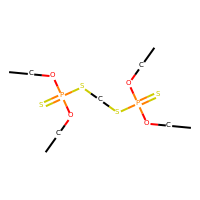
Ethion
| Chemical | Gene Symbol | Gene Name | Interaction source |
|---|---|---|---|
| Ethion | SLC6A3 | solute carrier family 6 member 3 | ToxCast |
| Ethion | AHR | aryl hydrocarbon receptor | ToxCast |
| Ethion | ESR1 | estrogen receptor 1 | CTD|ToxCast |
| Ethion | NR3C2 | nuclear receptor subfamily 3 group C member 2 | ToxCast |
| Ethion | MMP1 | matrix metallopeptidase 1 | ToxCast |
| Ethion | RXRB | retinoid X receptor beta | ToxCast |
| Ethion | AR | androgen receptor | ToxCast |
| Ethion | PGR | progesterone receptor | ToxCast |
| Ethion | TSHR | thyroid stimulating hormone receptor | ToxCast |
| Ethion | SREBF1 | sterol regulatory element binding transcription factor 1 | ToxCast |
| Ethion | OPRM1 | opioid receptor mu 1 | ToxCast |
| Ethion | COL3A1 | collagen type III alpha 1 chain | ToxCast |
| Ethion | NR1H4 | nuclear receptor subfamily 1 group H member 4 | ToxCast |
| Ethion | CXCL10 | C-X-C motif chemokine ligand 10 | ToxCast |
| Ethion | GSK3B | glycogen synthase kinase 3 beta | ToxCast |
| Ethion | L1RE1 | LINE1 retrotransposable element 1 | ToxCast |
| Ethion | ESR2 | estrogen receptor 2 | CTD|ToxCast |
| Ethion | NR1H3 | nuclear receptor subfamily 1 group H member 3 | ToxCast |
| Ethion | DUSP3 | dual specificity phosphatase 3 | ToxCast |
| Ethion | CD38 | CD38 molecule | ToxCast |
| Ethion | SLC5A5 | solute carrier family 5 member 5 | ToxCast |
| Ethion | NR1I3 | nuclear receptor subfamily 1 group I member 3 | CTD|ToxCast |
| Ethion | CYP2C19 | cytochrome P450 family 2 subfamily C member 19 | ToxCast |
| Ethion | NR3C1 | nuclear receptor subfamily 3 group C member 1 | ToxCast |
| Ethion | NR1H2 | nuclear receptor subfamily 1 group H member 2 | ToxCast |
| Ethion | VDR | vitamin D (1,25- dihydroxyvitamin D3) receptor | ToxCast |
| Ethion | JUN | Jun proto-oncogene, AP-1 transcription factor subunit | ToxCast |
| Ethion | CSF1 | colony stimulating factor 1 | ToxCast |
| Ethion | NR1I2 | nuclear receptor subfamily 1 group I member 2 | CTD|ToxCast |
| Ethion | SELE | selectin E | ToxCast |
DISCLAIMER
ExHuMId is a knowledgebase compiled through manual curation of published scientific literature wherein environmental contaminants were detected in human milk samples across India. We are not responsible for any errors in published scientific articles from where the human milk exposome specific to India was compiled. We are also not responsible for any omission of published scientific articles containing information on human milk exposome specific to India. Importantly, our primary goal to build this resource was to enable future research on human exposome studies specific to India. Hence, the views expressed in this work are solely based on our scientific understanding of the topic, and they do not necessarily reflect the views or policies of our employers or funders.